KLH Model Three loudspeaker
Robert Schryer | Dec 29, 2022

“Dear audio enthusiast.” Those were the user manual’s introductory words, not “Dear audiophile.” I stared at them for a few seconds, letting the implication of that greeting sink in. I don’t know if it was meant this way—perhaps not—but for me, this was a whistle call announcing that the KLH Model Three ($1799.98/pair) was not intended for those obsessed with having the best at all costs; it was meant for people who dig quality sound, period. It was also meant for people who dig that vintage-American-speaker look.
At first glance, the Model Three—I’ll call it the M3 for short—may seem retro, but I’d argue that its look is more timeless than old-fashioned. I’m staring at the sample pair as I write these words, and they by no means look out of place in the contemporary decor of my listening room. Any idea in what year the M3 was launched? Can’t think that far back? Try 2022. It’s a brand-new model that’s based on an old speaker, the company’s Model Five, released in 1968, updated with modern technology, parts, and materials unavailable when the original design came out. Think of today’s R2R DACs, but, to me at least, more sex appeal.
Aesthetically, the M3 exudes character. Its wide-baffled, rectilinear aspect isn’t just timeless. It’s iconic. I felt that on first sight, at the 2022 Montréal Audiofest. Despite being short—technically, it’s a bookshelf speaker—it radiates stoic strength. Back-tilted on a black, powder-coated, 14-gauge riser base, its square-jawed chin juts out defiantly. It’s like the face of an Eastwood Western character, except that, instead of a cigar, there’s a flap at the bottom to pull off the magnetically attached fabric grille. As tempted as I was initially to yank those flaps—I have a great distaste for fabric grilles—that impulse changed quickly. I was enchanted by their silvery color (officially “Stonewash Linen”), and soon loath to remove them. (That neverhappens.)
Another class of objects I don’t usually become enamored by, although I’m always happy to find in a shipping box, is a user manual. The M3’s manual (manuals, in fact—one with each speaker) might be the snazziest I’ve seen, let alone on a $1800 product. Sheathed in an attractive, letter-size envelope, it looked like a huge wedding invitation. Held in the hand, it feels like a quality print publication. Its content is also substantial. It is well-written, with an amiable, conversational tone, and informative. But why am I making such a big deal about a user manual? Because it’s your introduction to the company. It sets the tone for what will come next. A manual makes either a good or a bad impression. The M3’s made a good impression. It made me feel like I mattered to the company.
Would the M3 be of quality commensurate with the manual? I was well primed to find out.
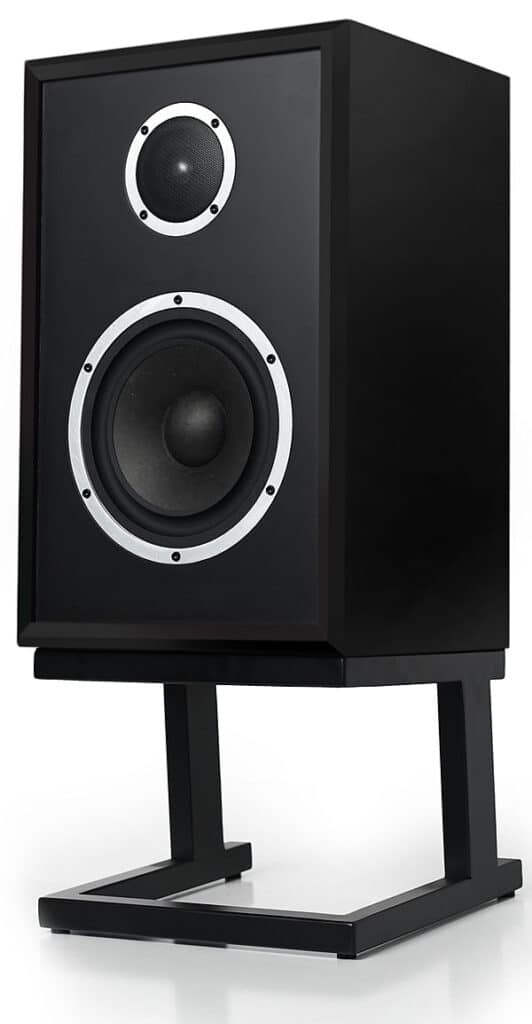
Design
The KLH Model Three may be new, but its core technology—the acoustic suspension design—arrived on the market in 1954, when audio engineers Edgar Villchur and Henry Kloss, cofounders of Acoustic Research, incorporated it in their company’s first loudspeaker, the AR-1. Three years later, Kloss and two AR employees struck out on their own to found KLH. Retaining the legal right to use the acoustic suspension design in their own speakers, they incorporated it in their first, the Model Five (M5). It was a hit.
The M3 shares many features with the new M5, which Ken Micallef reviewed in the September 2021 issue of Stereophile. The impedance of both is rated at 6 ohms. Both employ the same 1″ aluminum-dome tweeter, and both use a pulp-paper woofer cone, a cabinet constructed of structurally reinforced ¾” MDF, five-way binding posts, and a three-position “Acoustic Balance Control” knob at the back of the cabinet to adjust the speaker’s output level to suit room acoustics. Kerry Geist, KLH’s chief designer, explained in a conversation with Ken Micallef that “the switch attenuates … output above 400Hz … to deal with difficult room acoustics. The amount of attenuation is relatively small (0, –1.5dB, –3dB) … [and spans] a broad frequency range. The idea is to pull some excess energy out of an overly bright listening room.”
My listening room isn’t particularly bright, but I did notice a reduction in glare when I played recordings with some attenuation. Offsetting that, though, was a slight loss of detail and open-air expansiveness, so I kept the knob in the MID position, but in other rooms and situations, the Acoustic Balance Control could be helpful.
In contrast to the M5, the M3’s in-room sensitivity is specified as 88dB/2.83V/m; the M5’s is meaningfully higher, at 90.5dB/2.83V/m. The M3’s woofer has an 8″ cone, compared to the M5’s 10″, and its cabinet is considerably smaller. The main difference between the M5 and M3, though, is that the M5 has a midrange driver; the M3 doesn’t. Despite being a two-way instead of a three-way, the M3’s circuitry is no simpler, according to Geist, who told me that the parts count of the M3 is similar to that of the M5 because “there’s an additional tuning circuit in the upper passband of the woofer to provide some added EQ. Plus, the circuitry that supports the attenuation switch has to be a little more complex because the attenuator controls the tweeter and also the band above 400Hz in the woofer. There’s a simple filter added to provide that separation in the woofer passband.” He added, “The Model 3 has a 2nd-order network topology similar to the Model 5. Of course, the midrange circuitry is removed, so the woofer to tweeter crossover occurs at around 1600Hz.”
The M3 samples I received came in the English Walnut finish. Two other finishes are available: West African Mahogany and Nordic Noir.
The first word that came to mind when I pulled the M3 out of its box and viewed it up close was: Nice! With its beveled wood baffle and the pattern of its wood veneer, the M3 looked like fine furniture.
The user manual suggests breaking in the speakers for 8 hours, which seemed random, so I added another, oh, 151.8 just to be sure.
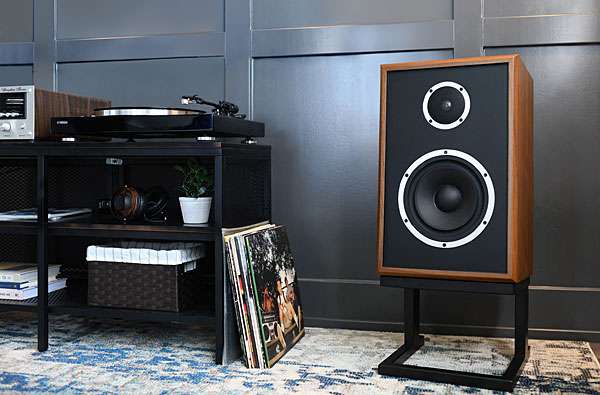
Listening
That manual I mentioned earlier claims that the M3 can “rival the largest loudspeakers.” I recalled my astonishment, at the Montreal audio show, at how big the M3 sounded. I remembered sitting in one of the few remaining seats, aligned against the back wall (footnote 1), wondering whether the sound I was hearing was coming from the bigger or the smaller pair of speakers that flanked the electronics. I’m sure it wasn’t just me because I also remember watching as the heads of the other visitors snapped left and right, from one speaker to the other. After a while, the host, grinning wickedly, revealed that we were indeed hearing the M3s. A collective ooh of admiration filled the room.
When the time came to position the M3s in my listening room, I hesitated. Tweeters and midranges had always been level with my ears; the M3 drivers were well below my ears, slanted upward. I wondered what the proper positioning technique was with low, inclined speakers. The user manual suggested I start with the speakers pointed directly at me, then gradually widen their radius of projection until I achieved balance between soundstage size and solid imaging focus and solidity. It worked like a charm. The speakers ended up about 8′ apart, 8′ from me, and toed in so they pointed about a foot outside my ears. I knew things were right when Richard Lehnert’s spoken introduction on the channel identification track on Stereophile‘s Test CD 2 (CD, STPH004-2) snapped into focus, like he was there in front of me.

After that, things went downhill. Fast. I played the title track from Nils Petter Molvær’s album Khmer (CD, ECM 1560 537 798-2), which begins with a languidly pulsing subterranean bass note from the left channel. Except this time, a trembling, fluttering sound mangled that note. The volume wasn’t even that high, but when I lowered it, the fluttering stopped.
Was the bass too deep for the M3’s paper cones to handle? Was the left speaker broken? I leaped from my couch, swapped the cables, L–>R and R–>L, then waited for the stygian bass beat to re-emerge, now from the right speaker. Same bloody thing! A warping fffrrrrr effect that rode the lowest bass notes, a parasitic overlay of static.
Did I, by freak chance, find the Achilles’ heel of the M3 right at the start?
I played the next track on Khmer, which has deep bass as well but not asdeep, and it was great. The bass sounded rich, expansive, and well defined, showing no sign of strain. Still, how could I review a speaker whose bass cone fluttered audibly when loud, low notes were played?

Seeking explanations and a solution, I darted off an email to Technical Editor John Atkinson. I rambled on about the M3’s 46Hz bass extension and asked whether this could be a defect or maybe an impedance incompatibility with my amplifier. John, bless his soul, answered right back. He sent me a download of the 1/3-octave low-frequency warble tones he created for Stereophile‘s Test CD 2 to help me locate the frequency region where the problem occurs. “I doubt that there is an impedance mismatch with the amplifier,” he said.
Footnote 1: Which means that I was experiencing some bass reinforcement, since the intensity of all standing waves peaks at hard room boundaries.
“First, check that the woofer is securely fastened to the baffle,” unaware that I was hearing the same thing from both speakers. “The screws might have come loose in shipping. Second, if the woofer screws are tight, it is possible that either the complete crossover or one of its components, most likely a heavy inductor, has come loose in shipping. If you can’t get inside the speaker to check this, I think you should ask for new samples.”
Whaaa? New samples? No! I had a deadline!
I pressed. “Could it be because the Model Three is a sealed box? That the lowest note is creating excess air inside the cabinet that’s bleeding through the cone?” Oops. “You have that upside down,” John said. “Sealed box woofers are naturally controlled below the low-frequency resonance. The woofer in a ported speaker, by contrast, is unloaded below the port resonance frequency, and the cone can undergo alarmingly high excursions with subsonic frequencies on recordings.”
Later, cruising down the highway in my peeling 2009 Dodge with the windows down, in deafening noise, brought ported speakers back to mind. And then it hit me. I sped home, practically tumbled down the stairs into my basement listening room, peered down at the speakers like a dad might at his enigmatic child, dropped to my knees, and with a silent prayer, removed those silvery grilles and set them aside. I then fired up that troublesome Molvær track and … Hallelujah! The rattle from hell was gone!
The relief I felt was exhilarating. It was a d’oh moment, for sure, but one that cleared the clouds inside my listening room and allowed me to continue this review with peace of mind.
The lesson of this story: If you’re going to listen to bass-heavy music through the Model Threes, get rid of those pretty grilles.
After grillegate, things were looking up. I needn’t have worried about the bass: Bass is one of the M3’s strong suits. That deep, disintegrating note at the beginning of Khmer? It was now big and smooth without a hint of disobedience. It was damped just right: juicy but not soppy. It had substance, physicality, integrity. It was timbrally nuanced, etched out in mutating. The soundstage? Wider than I expected. When those channel-alternating bass booms in Khmer showed up, they were farther apart than ever before, which allowed for more bass to fill in the space between the speakers, the musical equivalent of a double-stuff Oreo. The sound of Molvær’s trumpet blazed out, slicing the air, launching luminous shards. It was dynamic and alive, with realistic bite and a glowing complexion. It was incisive, fast, articulate.
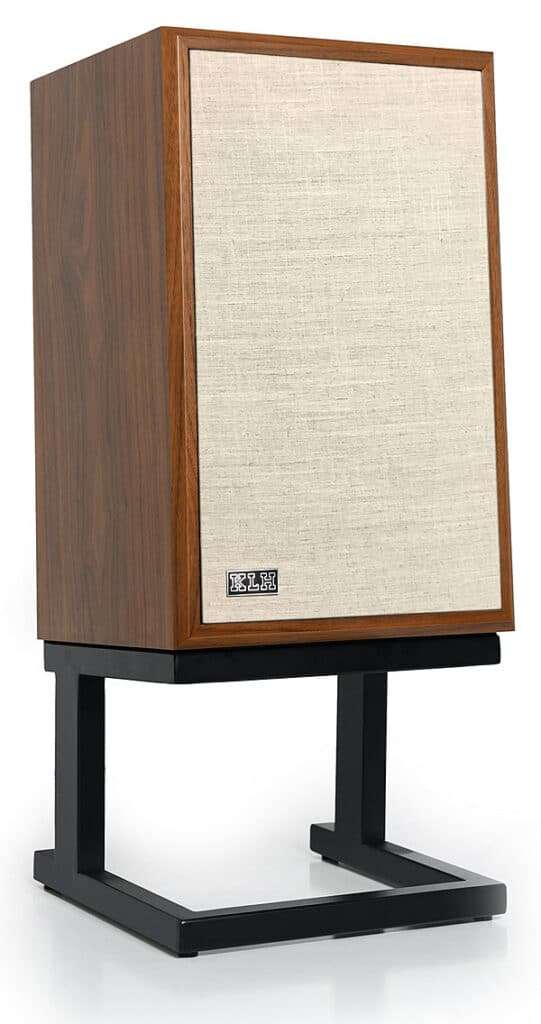
The sax sounded properly raspy and life-size. Compared to my Focal Aria K2 936s, the M3 showed more of the brass instruments’ metal, less of the musicians’ throaty fundamentals. The instruments didn’t sound bright so much as metallically silhouetted, with contoured profiles. And they didn’t mask the human player: I heard the artist behind the instrument.
I always assumed the dulcimer plucks that pan from left to right at the beginning of Khmer were computer generated and so mostly identical. But this time, I heard a real instrument being played in real time. I heard the technique: slight shifts in finger work, subtle changes in tonal intensity, a human playing. This was no studio gimmickry; it was human artistry. How could this be? Could the M3’s midband really be this transparent?
I could hardly wait to listen to the next track. As soon as I did, that double-stuff Oreo soundstage appeared again—big and warm, generating sensual, throbbing Middle Eastern dreamscapes until a drumbeat dropped center stage and took off like a bandit with the rest of the music. It felt invigorating. When the track was over, I listened to the next track, and the one after, until a little voice in my head interjected: “Dude, enough with the notes already! How about some crispy calamari?”
I recently reviewed the Monitor Audio Silver 500 7G. Music flowed effortlessly through the Silver 500, like water down a slide. The M3, on the other hand, seemed to eject the music; to push it out. It’s still effortless, but you sense a physical force propelling the music. The Silver 500’s sound is ethereal; the M3’s is grounded and earthy.

Erykah Badu’s 1997 debut album, Baduizm (CD, UND-53027), is great music but a missed opportunity. With higher sound quality, this album could have been amazing. True, Baduizm sold a gazillion copies, regardless of what audiophiles thought of its loud, wiry sound. I was curious to hear how the M3 would handle this type of recording.
I was pleasantly surprised. First, the M3 was revealing enough to remind me how compression methods differ: It clearly showed the degree of compression the songs had been subjected to. The less compressed songs were easier and more enjoyable to listen to. They sounded bigger, sweeter, fleshier, airier, and more detailed. Background vocals stretched out from the sides; the soundstage had depth and warmth; bass was vigorous.
More importantly—and this was the acid test—the M3 made this recording listenable to the point that my mind was able to get past the mediocre production and focus on Badu’s singing—to the way she sang, not just from a technical perspective. Badu inhabits the characters in her music, living their stories. She wasn’t just singing, I realized: She was acting!
Mesmerized, I turned up the volume. The M3 didn’t prettify her voice, which could still sound stringent, but it did allow the inherent musicality and humanness of the recording to penetrate my audio self-defense and make me receptive to the art. Music 1, dynamic compression 0.
“Chubb Sub,” from Medeski, Martin & Wood’s compilation Last Chance to Dance Trance (perhaps): Best of (1991-1996) (CD, Gramavision GCD 79520), is my go-to bass and transparency track. The music is bass heavy and mostly confined to a narrow vertical space. If you haven’t heard it, imagine standing on a sidewalk watching a fistfight in an alleyway between fat, bumptious bass tones, and you’ll get an idea of the mood of this piece. Too much bass will obscure much of the music, especially Medeski’s keyboard. The more transparent and well-balanced the playback gear, the more information emerges through the dark cluster.
The M3s peeled back the gloom to reveal the bloom. They lacked the transient speed and sharp-edged definition of my Focals and the Monitor Audios I reviewed, but they delivered the music with voluptuous, gangbuster’s bass that didn’t smother higher frequencies. I could distinguish clearly between the various bass lines and drum patterns and Medeski’s articulate forays on his keyboard. The M3 possessed a near-ideal balance between dark and light. I was able to appreciate the power of the bass and the artistic expression of each instrumental player.
That clinched it for me: The M3’s second strongest suit was transparency. Understated transparency; it didn’t call attention to itself. Detail wasn’t hyped. The M3 preserved the richness and warmth inherent in the music.
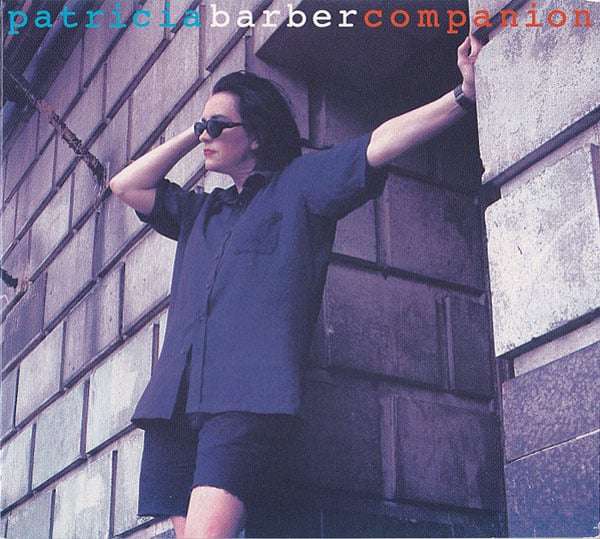
Patricia Barber’s Companion (CD, Blue Note 5229632) provided more proof that even though the standmount M3 has a tweeter just 24″ off the ground, it can still sound open and generous. The instruments on this recording stood well-proportioned on a spacious bandstand. On the track “The Beat Goes On,” Barber’s organ took up the whole front wall, every note clear-cut and texturally resplendent. Barber’s voice, thick with breath, had a rich, fleshy overtone. This was another recording I was tempted to listen to all the way through. A live recording that the M3s turned into live performance. Of course, they couldn’t push out the same volume of air as my twin-woofered Focals, but thanks to their balanced demeanor, the limitation wasn’t glaring. It was also the first time I noticed—all good speakers offer first-time musical reveals—how interlinked Barber’s singing was to her keyboard, how they played off each other like the two parts of a tango. This relationship came to the fore. I heard similar interplay among members of the rhythm section. Still, some parts stood out: a shaker’s angry rattle, the illumined resonance of the tambourine, the handclaps reflecting from every surface.
A moment came when I was listening to everything going on—Barber’s luscious vocals and colorful piano, the crisp, potent drum strokes behind her, the meaty bass licks, and the bongo hand taps—when I noticed how convincingly the M3s disappeared. I thought, “I can see a lot of people liking these speakers.”
And then came Radiohead’s mind-bending album Kid A (CD, EMI 529220) with its plethora of sonic textures. The M3s beamed the synth notes at the beginning of “Everything in Its Right Place” across my room in a kaleidoscope of brimming colors.
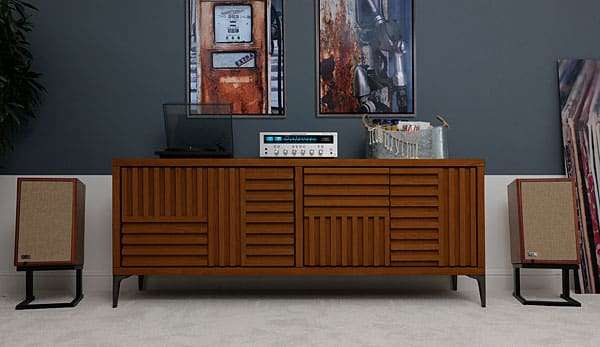
The title track is a grand spectacle of glittering, morphing, overlapping studio effects interspersed with Tom Yorke’s ghostly, warped vocals. The M3s delivered all of it: texture, scope, intricate arrangements, the music’s psychedelic, post-human aura. And when, midtrack, the synth chords rose in a wall of sound, it was almost orchestral in breadth, blanketing my room in a lush weave of musical threads and sparkling spangles. The presentation felt expansive, close, and enveloping.
When the song ended, I sat for a minute, digesting. Then I looked at those squat speakers, their square jaws jutting defiantly, shook my head, and smiled.
End
The Model Three was fun. I hesitated to use that word—fun—because it could be (mis)construed as meaning good but not quite audiophile-good. So let me be clear: The M3 delivered both fun and refined audiophile sound, at a price I consider almost laughably low. It delivers music in a way that made this long-time audiophile shake his head and smile.
I love all gear, even the crazy-expensive, boundary-pushing stuff, but I have a soft spot for earthy, classic, overachieving, approachable components with character, guts, and a human core.
My first impression was that the essence of the M3 was timelessness, but that isn’t quite right. After two months of living with them, I found their true spirit, and it’s not something you’d expect from an iconic design. The KLH Model Three possesses the spirit of youth—vitality, confidence, hope for the future. It has a young heart, like me.
Sidebar 1: Specifications
Description: Two-way, acoustic suspension, standmount loudspeaker with a three-position Mid-HF attenuation switch and a metal-frame, slant riser base (included). Driver complement: 1″ aluminum-dome tweeter; 8″ pulp-paper–cone woofer. Crossover frequency: 1.6kHz (2nd-order). Frequency response: 46Hz–20kHz ±3dB. Low-frequency extension: –10dB at 35Hz. Nominal impedance: 6 ohms. Minimum impedance: 3.7 ohms at 320Hz. In-room sensitivity: 88dB/2.83V/m. Free-field sensitivity: 85dB/2.83V/m. Power handling: 150W, 600W peak. Recommended amplification: 30–150W. In-room maximum SPL: 108dB. Inputs: gold-plated, five-way binding posts. Supplied accessory: slant riser base.
Dimensions: (w/o base) 12.3″ (311mm) W × 19″ (482mm) H × 10.5″ (267mm) D. Weight: 29lb (13.2kg).
Finish: English Walnut, West African Mahogany, or Nordic Noir.
Serial numbers of units reviewed: 20211100597 (listening), 20220401101 (measuring).
Price: $1799.98/pair. Approximate number of dealers: 185. Warranty: 10 years.
Manufacturer: KLH Audio, 984 Logan St., Noblesville, IN 46060. Tel: (833) 554-8326. Web: klhaudio.com.
Sidebar 2: Associated Equipment
Analog source: Rega P5 turntable with RB700 tonearm and Audio MusiKraft Denon DL-103 cartridge.
Digital source: Simaudio Moon 260D CD transport; Cambridge Audio EVO 150 streaming integrated amplifier (used as DAC).
Preamplifier: Sonic Frontiers SFP-1 Signature phono preamp.
Integrated amplifier: Grandinote Shinai.
Loudspeakers: Focal Aria K2 936, Monitor Audio Silver 500 7G.
Cables: Digital: Audience Studio One (RCA S/PDIF). Interconnect: Moon Audio Silver Dragon (RCA). Speaker: Audience Studio One. Power: Shunyata Research Black Mamba CX, LessLoss DFPC.
Accessories: Shunyata Research Venom PS8 power conditioner; a component rack and a wood plinth stand (under turntable) whose brand names are lost to time.—Rob Schryer
I used DRA Labs’ MLSSA system with a calibrated DPA 4006 microphone to measure the KLH Model Three’s frequency response in the farfield and an Earthworks QTC40 mike for the nearfield response of the woofer, both microphones used with an Earthworks preamplifier. I measured a different sample than those auditioned by Robert Schryer; its serial number was 20220401101.
The Model Three’s excellent manual includes a lot of useful advice on optimizing the balance of the speaker. A diagram indicates that with the Model Three sitting on its stand, the listener’s ears should be within a 20° vertical angle centered on the tweeter. I set the KLH on its angled stand and calculated that at an approximate distance of 96″ the listener’s ears, which on average are 36″ from the floor, would be on the tweeter axis. I therefore performed a complete set of measurements with the microphone placed on that axis. Except when noted otherwise, all the measurements were taken without the grille and with the Acoustic Balance switch set to MID (–1.5dB above 400Hz, according to the manual).
KLH specifies the Model Three’s free-field sensitivity as 85dB/2.83V/m. My B-weighted estimate was 85.6dB(B)/2.83V/m, within the margin of experimental error. The KLH’s impedance is specified as 6 ohms, with a minimum value of 3.7 ohms at 320Hz. My impedance measurement, taken with Dayton Audio’s DATS V2 system, indicated that the impedance magnitude remained above 6 ohms in the bass and treble and only dropped below 4 ohms with the Acoustic Balance switch set to HI (fig.1, bottom solid trace). The minimum value was 3.7 ohms at 304Hz—very close to the specification. The impedance is higher through the midrange and treble with the Acoustic Balance switch set to LO (fig.1, top solid trace). With the control set to MID, the magnitude lay between the two extremes in fig.1.
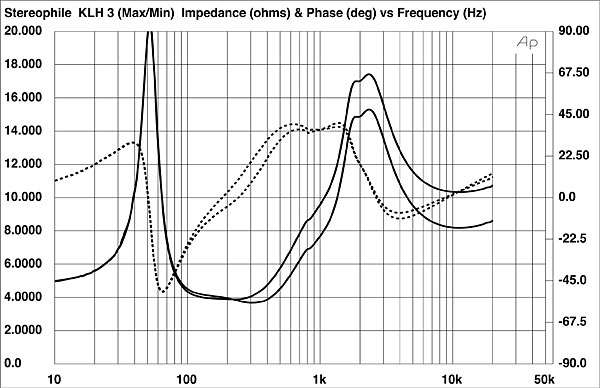
Fig.1 KLH Model Three, electrical impedance (solid) and phase (dashed) (2 ohms/vertical div.).
The Model Three appears to be a relatively easy load for the partnering amplifier. However, the electrical phase angle (dotted trace) is high in the upper bass and midrange. Consequently, the effective resistance, or EPDR )footnote 1), lies below 3 ohms between 64Hz and 156Hz and from 161Hz to 939Hz. The minimum EPDR is 1.9 ohms at 85Hz and 1.98 ohms at 456Hz. The Model Three will therefore work well with amplifiers that don’t have problems driving low impedances, and tube amplifiers will best be used from their 4 ohm output transformer taps.
The traces in fig.1 are free from the wrinkles that would imply the presence of enclosure resonances. When I investigated the cabinet’s vibrational behavior with a plastic-tape accelerometer, I found a resonant mode at 242Hz on all the panels and another just above 1kHz on the side panel (fig.2). These modes are relatively low in level and have a high Q (Quality Factor), so they should not have audible consequences.
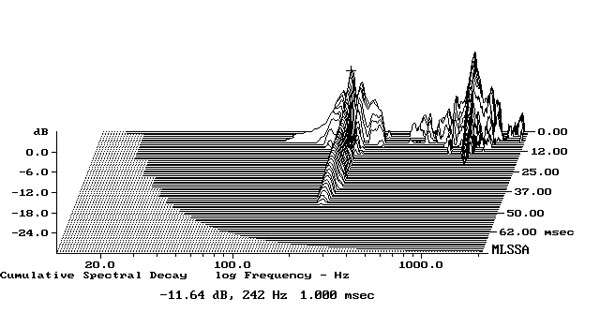
Fig.2 KLH Model Three, cumulative spectral-decay plot calculated from output of accelerometer fastened to center of sidewall (MLS driving voltage to speaker, 7.55V; measurement bandwidth, 2kHz).
The woofer’s response, measured in the nearfield (fig.3, black trace below 300Hz), peaks between 70Hz and 120Hz, rolling off below that region with the usual sealed-box slope of 12dB/octave. The apparent peak in the woofer’s output compared with the midrange level will be due to the nearfield measurement technique, which assumes that the drive unit is mounted in a baffle that extends to infinity in both planes. Although fig.1 seems to show that the woofer is tuned to a fairly high 52Hz, the relatively slow rolloff below the tuning frequency means that the low frequencies will sound more extended in-room.
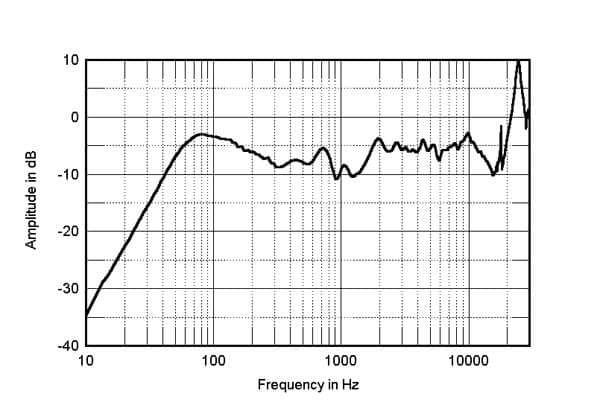
Fig.3 KLH Model Three, anechoic response on tweeter axis at 50″, averaged across 30° horizontal window and corrected for microphone response, with the nearfield woofer response plotted below 300Hz.
The trace above 300Hz in fig.3 shows the Model Three’s quasi-anechoic farfield response, averaged across a 30° horizontal window centered on the tweeter axis. Other than a small peak at 700Hz, the midrange seems shelved down by 3–5dB compared with the level in the region covered by the tweeter. (The crossover frequency is specified as 1.6kHz.) The tweeter’s output is respectably flat, though it rolls off in the top octave before the output rises due to the high-Q, high-amplitude “oil-can” aluminum-dome resonance at 24.2kHz. There is also a very high-Q resonance at 18kHz. I have no idea what this will be due to, but the tweeter of the KLH Model Five, which Ken Micallef reviewed in October 2021, behaved identically in this respect (footnote 2).
Fig.3 was taken without the grille and with the Acoustic Balance switch set to MID. Repeating the response measurement with the control set to HI increased the level between 500Hz and 20kHz by up to 1dB; setting it to LO reduced the output in the same region by 1dB. In neither case did the shape of the response change. The grille lowered the tweeter’s output by 2–3dB between 3kHz and 6kHz and between 8kHz and 12kHz.
Fig.4 shows the Model Three’s horizontal dispersion, normalized to the response on the tweeter axis, which thus appears as a straight line. The off-axis behavior is complicated, though it looks like the lack of energy between 900Hz and 1.2kHz in the tweeter-axis response deepens to the speaker’s sides. The dispersion in the vertical plane is shown in fig.5. A suckout appears in the crossover region 10° above and 15° below the tweeter axis. It also appears that the KLH’s output in the low treble is a little better balanced 5° below that axis, though this will be at a listening distance greater than 96″.
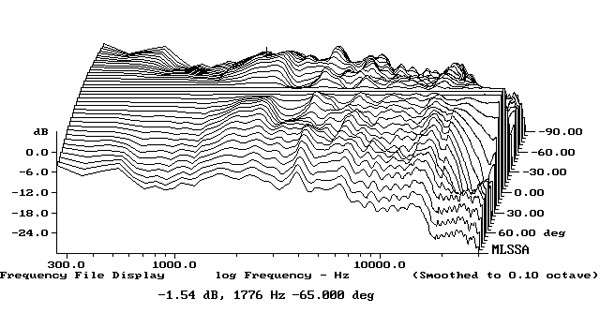
Fig.4 KLH Model Three, lateral response family at 50″, normalized to response on tweeter axis, from back to front: differences in response 90–5° off axis, reference response, differences in response 5–90° off axis.
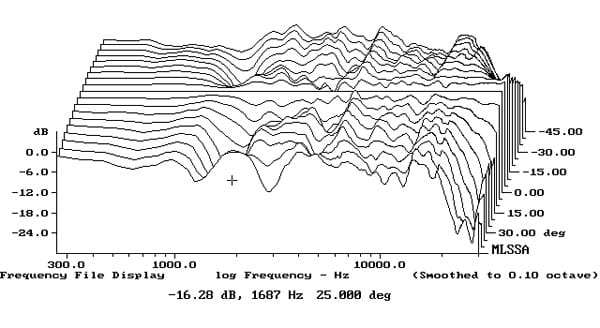
Fig.5 KLH Model Three, vertical response family at 50″, normalized to response on tweeter axis, from back to front: differences in response 45–5° above axis, reference response, differences in response 5–45° below axis.
Turning to the time domain, the Model Three’s step response (fig.6) indicates that the tweeter and woofer are both connected in positive acoustic polarity, with the tweeter’s output arriving first at the microphone. The decay of its step doesn’t uite coincide with the start of that of the woofer, which suggests that the optimal blend of the two driver outputs in the time domain will occur just below the tweeter axis. The KLH’s cumulative spectral-decay plot (fig.7) is relatively clean, though ridges of decayed energy are present at the frequencies of the two tweeter resonances and just below 1kHz.
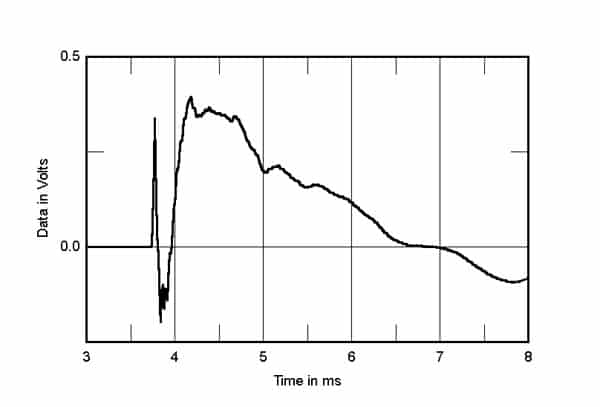
Fig.6 KLH Model Three, step response on tweeter axis at 50″ (5ms time window, 30kHz bandwidth).
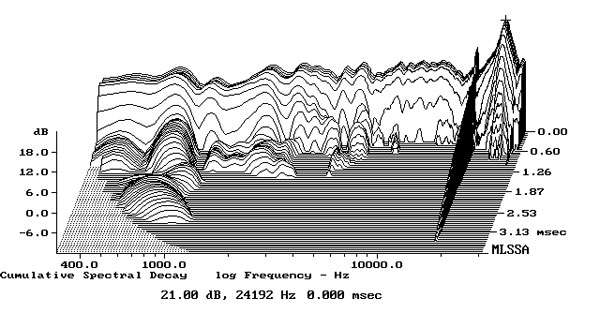
Fig.7 KLH Model Three, cumulative spectral-decay plot on tweeter axis at 50″ (0.15ms risetime).
The KLH Model Three’s measured performance suggests that care needs to be taken in setup and positioning in the room, and the Acoustic Balance switch utilized, to get the most neutral tonal balance.—John Atkinson
Footnote 1: EPDR is the resistive load that gives rise to the same peak dissipation in an amplifier’s output devices as the loudspeaker. See “Audio Power Amplifiers for Loudspeaker Loads,” JAES, Vol.42 No.9, September 1994, and stereophile.com/reference/707heavy/index.html.